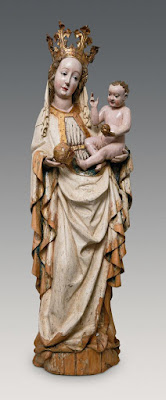One of the most important medieval art history exhibitions organized in Hungary was the one dedicated to King and Emperor Sigismund in 2006.
Shown first in Budapest and later in Luxembourg, the exhibition was accompanied by a catalog published in Hungarian, German and French. Several other publilcations were also published in conjunction with the event, including the acts of a conference held a year before. The full list of publications can be seen on the website of the exhibition. A few photos of the exhibition are available on my website.
The exhibition catalogue, titled Sigismundus - Rex et Imperator: Kunst und Kultur zur Zeit Sigismunds von Luxemburg, 1387-1437, was edited by Imre Takács, with the assistance of Zsombor Jékely, Szilárd Papp, and Györgyi Poszler. It was published Philipp von Zabern of Mainz (ISBN 978-3-8053-3626-0).
Over the years, a number of detailed reviews have been written of this exhibition catalog. I am listing a few of them below. Some reviews also discuss the conference volume, edited by Michel Pauly - François Reinert and titled Sigismund von Luxemburg: Ein Kaiser in Europa. Tagungsband des internationalen historischen und kunsthistorischen Kongresses in Luxemburg, 8-10. Juni 2005.
- Review by Tim Juckes in Renaissance Studies (Oxford), 21 (2007), 99-105, pdf version in Google docs or through CiteULike.
- Review by Len Scales in English Historical Review, 124, (2009), No. 509., 944-946, pdf version in Google docs or through CiteULike.
- Review by Ana Maria Gruia in the online journal Studia Patzinaka (Journal of Medieval and Early Modern Studies), No. 3 (2006), direct link to pdf version.
- Review by Ansgar Frenken on H-Net Reviews (H-Soz-u-Kult), 2007.
- Overview of the project by Ernő Marosi in The Hungarian Quarterly, 2006. Marosi also wrote a review of the catalogue in
- Overview on Chronico.de by Marcel Schwarzenberger, 2006.
- Hungarian language review by Tünde Wehli in Új Művészet, 2006.
- Another Hungarian review by János Végh, in Művészettörténeti Értesítő 2007/1.
In addition, there is a long review by Štefan Oriško in, Ars (Bratislava), 39 (2006/1), 31-52 (abstract here) and also by Matthew Palmer in Acta Historiae Artium, 48 (2007), 341-349, neither of which is available online.
An important review by Klara Benešovská is not only about the Sigismundus exhibition, but also about another important venture dedicated to the Luxemburg dynasty, the exhbition Prague - The Crown of Bohemia, shown in New York and Prague. It was published in Perspective, La revue de l'INHA 2008/1, 138-145. For more on the Luxemburg dynasty, you should also read the review of the conference volume Prague and Bohemia, edited by Zoë Opačić, in The Medieval Review. This period, one of the high points of Central European Art, will also be the subject of an international colloquium organized in Maribor, Slovenia, early next year.





